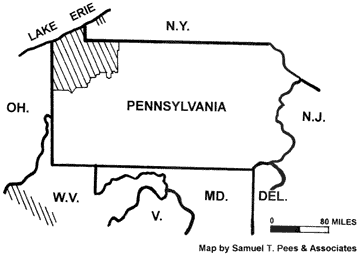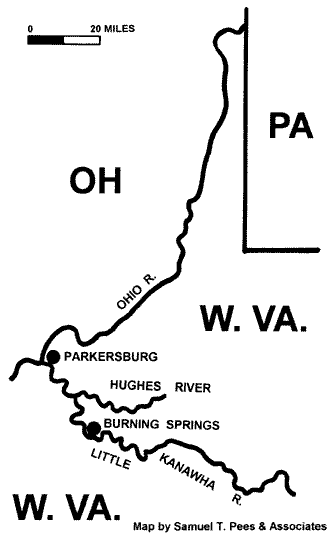 |
||||||
EARLY OIL PIPELINES, U.S.A.
Oil Pipeline Idea
According to McLaurin (1896) the earliest idea of a pipeline to carry crude oil was put forth in Parkersburg, West Virginia, in November 1860 by young Samuel Duncan Karns. The historian, Ernest Miller, reveals that Karns was only 17 years old when he was struck by this brainstorm (Miller, 1974). Karns' plan involved laying a six inch diameter wooden line to carry oil from an old salt well at Burning Springs in Wirt County to a refinery being built at Parkersburg on the Ohio River. The salt well may have been the one drilled by the Rathbone brothers in the1840's (White in Hennen, 1911). From the very beginning the original salt well had been distressed by an influx of oil which had increased to the point that suitable brine was no longer obtainable. It was later deepened to 300 feet at about the time Drake drilled his 1859 well in Pennsylvania (White, 1904). By deepening it the operators hoped to obtain pure medicinal and lubricating oil. After the deepening and successful work-over, the salt well began to produce 36 BOPD oil by pump.
The Karns pipeline would be 36 miles long (Redwood, et al, 1913) and Karns would also have contemplated at least one river crossing (Hughes River) and several smaller streams and ravines. Karns picked a route that he thought would allow the oil to flow by gravity. His father, who was against the idea, apparently thought that his son had gone daft. The Civil War which broke out in 1861 turned attention away from this idea, and the line was never laid. Eventually, of course, pipelines did come to the Burning Springs oilfield.
It seems to the writer that Sam Karns must have forecast considerable future production involving a number of projected wells at Burning Springs because oil from the single reworked oil-producing salt well would hardly require a pipeline in view of the fact that the small production could easily be floated down the Little Kanawha River in barrels on flat boats to Parkersburg. Karns and his father were buying up and leasing other lands in the Burning Springs area for oil purposes (McKain and Allen, 1994). Young Karns seems to have been born with the canny sense of a promoter, a valued attribute in the oilfields. He buttonholed C.D. Wheeler, a noted oil investor, who evinced some interest in the pipeline idea but couldn't act due to the upcoming war between the states (McLaurin, 1896).
|
||
|
![]()
| © 2004, Samuel T. Pees all rights reserved |
|

